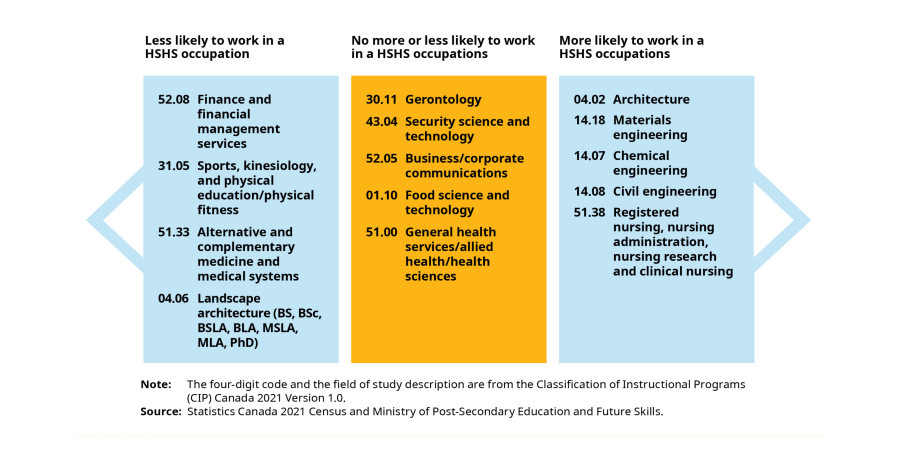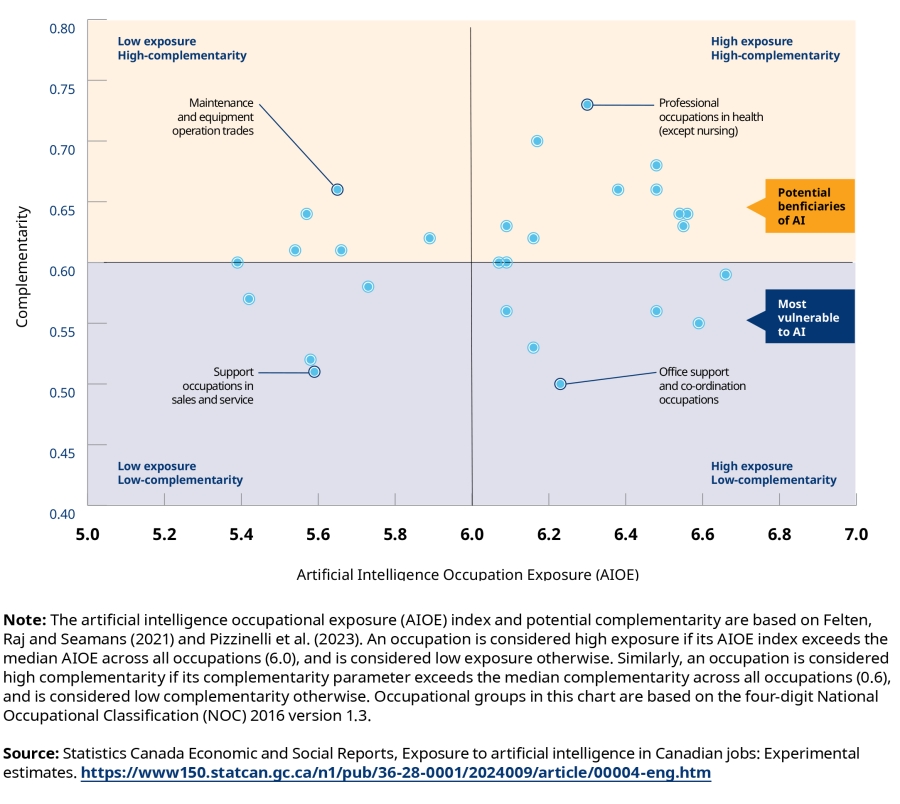Overview
Minister's message
About the B.C. Labour Market Outlook
The 2025 edition of the B.C. Labour Market Outlook (“Outlook”) is a 10-year forecast covering the period from 2025 to 2035. It provides an estimate of future labour supply for B.C. by occupation, as well as labour demand by industry, occupation, education and training, and development region. It also identifies which occupations will offer the most opportunity, as well as the level of education and training that each occupation typically requires.
It is intended for students, job seekers and those considering a career change, and it will also be of value for educators and planners, employers and governments. The Outlook also plays a role in making the B.C. labour market more inclusive by providing Indigenous communities with access to information about labour demand, both across the province and within the regions where they live. It can help those who are underrepresented in the labour market — people of colour, immigrants, women and individuals living with disabilities — learn about the opportunities available to them.
View the full report (PDF) for details.

How reliable is the Labour Market Outlook?

The Labour Market Outlook has been published nearly every year since 2011 and uses the most reliable, relevant and up-to-date data from sources that include BC Stats, the B.C. Ministry of Finance, Statistics Canada and other federal departments. Employers, unions, industry groups and post-secondary institutions were also consulted to test the validity of these projections.
However, the Labour Market Outlook is a forecast and is not intended to be interpreted as a definitive prediction about what will happen in the future. The Outlook, like other labour market projections, should instead be understood as a tool for investigating what the labour market might look like in the years ahead according to various assumptions about possible future change. The accuracy of the projections depends on several factors. Some events — like economic crises, pandemics and natural catastrophes — are difficult to anticipate and can affect the growth and composition of the labour market. For this reason, the ministry revises the labour market forecasts on a regular basis to take into account changing circumstances.
To learn more about the specialized economic modelling system and how this forecast was developed, check out the Definitions and Methodology Tab.
What are the major changes in this edition?
The most significant change in this year’s forecast stems from an updated immigration outlook, based on the Federal Immigration Levels Plan released in November 2024. This plan reduced Canada’s target for permanent residents from 500,000 to 395,000 for 2025, with further declines anticipated in 2026 and 2027. In addition, temporary residents were capped at 5 percent of the total population, suggesting a substantial outflow in the coming years. Total refugee and protected admissions targets were also lowered, adding to the reduction. This change weakens population growth to 0.9 percent per year from 1.6 percent in the previous Outlook.
The Outlook incorporates slower expected growth than the previous forecast — reflecting in part the economic uncertainty posed by tariffs. Nearly 14 percent of all businesses in British Columbia, whether they are engaged in trade or not, anticipate that the imposition of tariffs by the United States on imports from Canada would have a high level of impact on their business. It is also assumed that the softwood lumber, steel and aluminum sectors could face additional risks should the tariffs remain in place. However, the production ramp-up at LNG Canada and increased efforts to diversify trade will to some extent offset slower trade activity in other areas.
Weaker population growth, because of slowing immigration, will reduce household formation and in turn investment in new homes. Housing starts are expected to average 49,000 per year over the forecast period, down slightly from the previous forecast, which will somewhat temper growth in the construction industry.
Highlights

Over the next decade (2025-2035), it is projected that there will be 1,052,000 job openings in British Columbia. This is about 70,000 fewer job openings than projected in the 2024 edition of the Outlook, mainly due to a slower population forecast in this year’s report. Employment is expected to reach 3.3 million by 2035 (an annual average growth rate of 1.2 percent).
As B.C.’s population ages over the next decade, we anticipate there will be 687,000 job openings to replace retiring workers (65 percent of the total). The remaining 35 percent of the 10-year total job openings — 365,000 new jobs — will be created through economic growth. Filling these future job openings will involve multiple sources of labour supply:
- Immigration is expected to supply less than a third of the new workers B.C. is expected to need over the next 10 years. This is a large decline from the 2024 Outlook when it was assumed that immigration would supply almost half of all new workers over the 10-year forecast period.
- Over the next decade, approximately 510,000 young people are expected to enter the labour force for the first time — 14,000 fewer than projected in the 2024 Outlook. This decline is primarily driven by reduced immigration to B.C., as newcomers tend to be younger and often arrive with families whose children eventually join the labour market.
- Workers from other parts of Canada are expected to account for 6 percent.
The 2025 edition of the Outlook forecasts that over the next 10 years labour demand will outpace labour supply. This difference can be resolved though supply-side measures like increasing labour market participation, attracting more people to B.C., or future increases in immigration levels. It could also be resolved through demand-side measures like greater reliance on AI and automation. Most importantly, if workers don’t have the education, skills and training to meet the labour market demands of tomorrow, future employment growth will be slower than anticipated. Therefore, ensuring that workers have the skills that match the opportunities in an evolving labour market is key to ensuring high employment.
Education and Training
TEER
Canada’s National Occupational Classification (NOC) system uses a framework known as TEER (Training, Education, Experience and Responsibilities) to identify the level of education and training required for an occupation. The TEER framework groups all occupations into six categories, each defined by the amount and type of training and education an individual requires to enter and perform the duties of the occupation. TEER also considers the experience required and the complexity of the responsibilities involved in the work.
Over the next decade, 847,200 job openings, or 76 percent of the total job openings, will generally require some level of post-secondary education or training, or management or supervisory experience (TEERs 0, 1, 2 and 3).
| Training, Education, Experience and Responsibilities | Job Openings | % of Total | |
|---|---|---|---|
| Training, Education, Experience and Responsibilities | TEER 0 Management | 178,500 | 15.9% |
| Training, Education, Experience and Responsibilities | TEER 1 University degree | 239,100 | 21.3% |
| Training, Education, Experience and Responsibilities | TEER 2 College or apprenticeship (two or more years) | 237,900 | 21.2% |
| Training, Education, Experience and Responsibilities | TEER 3 College or apprenticeship (less than two years) | 191,700 | 17.1% |
| Training, Education, Experience and Responsibilities | TEER 4 Secondary school | 141,500 | 12.6% |
| Training, Education, Experience and Responsibilities | TEER 5 No formal education | 131,300 | 11.7% |
Return on investment in education and training

An important use of the Outlook is to help parents and prospective students choose a field of study that aligns with their interests and provides a path to positive employment opportunities. While educational pathways often lead to specific occupations, sometimes a particular field of study can lead to many possible careers.
To capture the idea of a positive employment opportunity, it is possible to look at the likelihood of a specific field of study leading to a high-skill, high salary (HSHS) occupation.
In the table below, a variety of fields of study for bachelor’s degrees are shown. The analysis suggests some have a greater likelihood of being associated with a HSHS occupation, including registered nursing and many engineering fields. Similar data for different levels of educational attainment (e.g., master’s degrees or college diplomas) is available in the BC Data Catalogue.


B.C. Labour Market Outlook: 2024 Edition
Review the B.C. Labour Market Outlook: 2024 Edition forecast in the complete (PDF) report.
Industry Outlook
Industry overview

Over the next decade, five industries will generate more than half (56 percent) of the job openings in British Columbia:
- Health care and social assistance (178,100 job openings; 16 percent of the total)
- Professional, scientific and technical services (150,300 job openings; 13 percent of the total)
- Retail trade (123,700 job openings; 11 percent of the total)
- Construction (99,600 job openings; 9 percent of the total)
- Educational services (79,800 job openings; 7 percent of the total)
The table shows that the need to replace retiring workers will result in more than half of the job openings in all major industries over the next 10 years. The exception is the professional, scientific and technical services industry, where expansion plays a larger role.
| Industry | Expansion | Replacement | Total Job Openings | |
|---|---|---|---|---|
| Industry | Health care and social assistance | 87,200 | 90,900 | 178,100 |
| Industry | Professional, scientific and technical services | 83,600 | 66,700 | 150,300 |
| Industry | Retail trade | 49,100 | 74,700 | 123,700 |
| Industry | Construction | 41,800 | 57,900 | 99,600 |
| Industry | Educational services | 26,400 | 53,400 | 79,800 |
| Industry | Finance, insurance and real estate | 21,700 | 44,400 | 66,100 |
| Industry | Accommodation and food services | 30,000 | 34,600 | 64,600 |
| Industry | Transportation and warehousing | 19,200 | 37,700 | 56,900 |
| Industry | Public administration | 17,500 | 38,900 | 56,500 |
| Industry | Manufacturing | 12,000 | 44,300 | 56,200 |
Industry insights
Health care and social assistance
This industry continues to have the most job openings of any industry over the next decade due to an aging population.
Professional, scientific and technical services
The rapid advancement of technology, especially in fields like computer systems design, engineering and consulting services, is driving demand for professional, scientific and technical services.
Construction
Construction continues to benefit from significant investments in infrastructure projects, housing developments and commercial real estate, particularly in urban areas like Metro Vancouver. The provincial government’s focus on affordable housing, transportation infrastructure and green building initiatives will continue to fuel demand in this sector.
Finance, insurance and real estate
Job openings in the finance, insurance and real estate industry are forecast to be quite strong in response to the increased demand in construction, particularly residential construction. Compared to the previous forecast, the number of job openings due to expansion has more than doubled due to higher demand for occupations such as financial managers, loans officers, real estate agents and property managers.
Manufacturing
The manufacturing industry had the smallest number of job openings among the top 10 industries, due to the relatively small number of expansion openings that are expected. This industry has an aging workforce and growth is expected to be flat, primarily because of slowdowns in wood product manufacturing.


B.C. Labour Market Outlook: 2024 Edition
Review the B.C. Labour Market Outlook: 2024 Edition forecast in the complete (PDF) report.
Occupational Outlook
Occupational overview
Occupations are organized into 10 broad categories, according to the NOC 2021 system. Between 2024 and 2034, the following five occupational groups are expected to account for nearly 80 percent of the projected job openings in B.C.:
- Sales and service (252,100 job openings; 23 percent of the total)
- Business, finance and administration (202,700 job openings; 18 percent of the total)
- Trades, transport and equipment operators and related (186,500 job openings; 17 percent of the total)
- Education, law and social, community and government services (135,000 job openings; 12 percent of the total)
- Natural and applied sciences and related (112,100 job openings; 10 percent of the total)
As shown in the figure below, replacement job openings will outpace expansion job openings in nine of the 10 broad occupational groups over the next decade, with the only exception being natural and applied sciences and related occupations.
| Occupational Group | Expansion | Replacement | Total Job Openings | |
|---|---|---|---|---|
| Occupational Group | Sales and service | 103,100 | 149,100 | 252,100 |
| Occupational Group | Business, finance and administration | 74,000 | 128,700 | 202,700 |
| Occupational Group | Trades, transport and equipment operators and related | 66,400 | 120,100 | 186,500 |
| Occupational Group | Education, law and social, community and government services | 53,000 | 82,000 | 135,000 |
| Occupational Group | Natural and applied sciences and related | 58,500 | 53,600 | 112,100 |
| Occupational Group | Health | 54,000 | 55,400 | 109,300 |
| Occupational Group | Art, culture, recreation and sport | 21,700 | 24,100 | 45,800 |
| Occupational Group | Manufacturing and utilities | 8,600 | 28,000 | 36,600 |
| Occupational Group | Legislative and senior management | 6,500 | 15,700 | 22,200 |
| Occupational Group | Natural resources, agriculture and related production | 3,000 | 14,700 | 17,700 |
High opportunity occupations
All occupations play an important role in British Columbia’s economy, but some jobs provide more opportunities than others. High Opportunity Occupations (HOOs) are occupations that are forecasted to have higher demand, higher wages and more opportunities over the coming decade. Each edition of the Labour Market Outlook includes newly identified HOOs that capture the current and anticipated state of the labour market to help individuals make informed career decisions.
The occupations classified as HOOs overwhelmingly require some form of post-secondary education, indicating the importance of education and training over the coming decade.
For a complete list of all HOO occupations, check out the High Opportunity Occupations page or Appendix 6 in the 2024 Labour Market Outlook report (PDF).

B.C. Labour Market Outlook: 2024 Edition
Review the B.C. Labour Market Outlook: 2024 Edition forecast in the complete (PDF) report.
Regional Outlook
The seven development regions in B.C. all have unique economies, labour market conditions and demographics. As a result, each region offers distinct job opportunities, which are highlighted under their own individual sections below.
[SSOT] Employment and Job Openings by Development Region, B.C. (2024-2034)
Total of regions may not sum to the B.C. total due to rounding.







| Region | Employment (2024) | Annual Employment Growth Rate (2024-2034) | Job Openings (2024-2034) | |||
|---|---|---|---|---|---|---|
| Expansion | Replacement | Total | ||||
| Regions | Vancouver Island/Coast | 445,800 | 1.1% | 49,590 | 117,140 | 166,740 |
| Regions | Mainland/Southwest | 1,819,070 | 1.7% | 347,180 | 407,510 | 754,690 |
| Regions | Thompson-Okanagan | 305,620 | 1.2% | 37,660 | 84,200 | 121,860 |
| Regions | Kootenay | 79,790 | 0.5% | 4,280 | 22,030 | 26,320 |
| Regions | Cariboo | 86,510 | 0.4% | 2,840 | 20,640 | 23,490 |
| Regions | Northeast | 36,320 | 0.6% | 2,370 | 8,820 | 11,190 |
| Regions | North Coast and Nechako | 44,180 | 1.0% | 4,760 | 10,940 | 15,690 |
| British Columbia | 2,817,300 | 1.4% | 448,690 | 671,280 | 1,119,970 | |
Vancouver Island/Coast
The Vancouver Island/Coast region is expected to see 166,700 job openings over the next 10 years. Driven largely by an aging population, most of these opportunities (70 percent) will result from replacing workers, mainly due to retirement, while the remaining 30 percent will stem from new jobs created by economic growth. Employment demand across all industries is expected to grow at an annual rate of 1.1 percent, mirroring the region’s population growth rate during the same period.
| Industry | Employment (2024) | Annual Employment Growth Rate (2024-2034) | Job Openings (2024-2034) | |||
|---|---|---|---|---|---|---|
| Expansion | Replacement | Total | ||||
| Industry | All industries | 445,800 | 1.1% | 49,590 | 117,140 | 166,740 |
| Industry | Hospitals | 30,800 | 2.3% | 7,970 | 7,820 | 15,790 |
| Industry | Other retail trade (excluding cars, online shopping and personal care) | 43,250 | 0.2% | 630 | 9,690 | 10,320 |
| Industry | Ambulatory health care services | 15,290 | 2.7% | 4,720 | 4,270 | 8,990 |
| Industry | Elementary and secondary schools | 20,610 | 0.9% | 2,000 | 6,010 | 8,000 |
| Industry | Food services and drinking places | 26,110 | 1.1% | 3,090 | 4,470 | 7,550 |
Mainland/Southwest
Job openings in the Mainland/Southwest region are expected to total 754,700 over the coming decade. Opportunities arising from replacing workers, mainly due to retirement, will be slightly higher (54 percent) than those created by economic growth (46 percent). Employment demand across all industries is forecast to grow at an annual rate of 1.7 percent over the next 10 years, aligning with the region’s population growth rate during the same period.
| Industry | Employment (2024) | Annual Employment Growth Rate (2024-2034) | Job Openings (2024-2034) | |||
|---|---|---|---|---|---|---|
| Expansion | Replacement | Total | ||||
| Industry | All industries | 1,819,070 | 1.7% | 347,180 | 407,510 | 754,690 |
| Industry | Other retail trade (excluding cars, online shopping and personal care) | 160,620 | 1.7% | 31,120 | 32,840 | 63,960 |
| Industry | Computer systems design and related services | 70,410 | 4.3% | 38,320 | 16,210 | 54,530 |
| Industry | Hospitals | 92,230 | 2.5% | 26,940 | 20,820 | 47,760 |
| Industry | Legal, accounting, design, research and advertising services | 92,060 | 1.9% | 19,630 | 19,400 | 39,030 |
| Industry | Food services and drinking places | 103,710 | 1.5% | 18,020 | 16,970 | 34,990 |
Thompson-Okanagan
In the next 10 years, the Thompson-Okanagan region is expected to have 121,900 job openings. About 31 percent of these jobs will result from economic growth and the remaining 69 percent will come from replacing workers, mainly due to retirement. Employment demand is expected to grow at an average annual rate of 1.2 percent over the next decade, comparable to the projected 1.4 percent annual population growth rate during the same period.
| Industry | Employment (2024) | Annual Employment Growth Rate (2024-2034) | Job Openings (2024-2034) | |||
|---|---|---|---|---|---|---|
| Expansion | Replacement | Total | ||||
| Industry | All industries | 305,620 | 1.2% | 37,660 | 84,200 | 121,860 |
| Industry | Other retail trade (excluding cars, online shopping and personal care) | 29,950 | 0.5% | 1,480 | 6,990 | 8,470 |
| Industry | Hospitals | 13,790 | 2.3% | 3,600 | 3,960 | 7,560 |
| Industry | Specialty trade contractors | 17,090 | 1.3% | 2,430 | 5,040 | 7,470 |
| Industry | Food services and drinking places | 18,700 | 1.1% | 2,290 | 3,250 | 5,530 |
| Industry | Residential building construction | 10,660 | 1.4% | 1,600 | 3,350 | 4,960 |
Kootenay
Over the next decade, the Kootenay region is projected to see 26,300 job openings. Only about 16 percent of these will result from economic growth, while the remaining 84 percent will stem from replacing workers, mainly due to retirement. Employment demand is expected to grow at an average annual rate of 0.5 percent, closely aligned with the projected population growth rate of 0.5 percent over the same period.
| Industry | Employment (2024) | Annual Employment Growth Rate (2024-2034) | Job Openings (2024-2034) | |||
|---|---|---|---|---|---|---|
| Expansion | Replacement | Total | ||||
| Industry | All industries | 79,790 | 0.5% | 4,280 | 22,030 | 26,320 |
| Industry | Other retail trade (excluding cars, online shopping and personal care) | 6,690 | 1.0% | 680 | 1,680 | 2,360 |
| Industry | Mining | 5,790 | 0.5% | 270 | 1,820 | 2,090 |
| Industry | Ambulatory health care services | 3,280 | 1.2% | 430 | 1,010 | 1,430 |
| Industry | Elementary and secondary schools | 4,100 | 0.2% | 60 | 1,200 | 1,260 |
| Industry | Food services and drinking places | 4,030 | 1.0% | 450 | 740 | 1,190 |
Cariboo
In the next 10 years, the Cariboo region is expected to generate 23,500 job openings. About 12 percent of these will be driven by economic growth, while the remaining 88 percent will result from the need to replace workers, mainly due to retirement. Employment demand is projected to grow at an average annual rate of 0.4 percent over the next decade, closely mirroring the region’s expected annual population growth of 0.4 percent.
| Industry | Employment (2024) | Annual Employment Growth Rate (2024-2034) | Job Openings (2024-2034) | |||
|---|---|---|---|---|---|---|
| Expansion | Replacement | Total | ||||
| Industry | All industries | 86,510 | 0.4% | 2,840 | 20,640 | 23,490 |
| Industry | Hospitals | 6,330 | 1.6% | 1,130 | 1,530 | 2,660 |
| Industry | Other retail trade (excluding cars, online shopping and personal care) | 7,920 | 0.2% | 100 | 1,640 | 1,740 |
| Industry | Specialty trade contractors | 4,000 | 1.5% | 660 | 1,000 | 1,660 |
| Industry | Paper manufacturing | 2,110 | 1.6% | 390 | 670 | 1,050 |
| Industry | Nursing and residential care facilities | 1,700 | 2.3% | 450 | 450 | 910 |
Northeast
Over the next 10 years, the Northeast region is expected to generate 11,200 job openings. Of these, 21 percent will be new jobs created by economic growth, while the remaining 79 percent will result from replacing workers, mainly due to retirement. Employment demand is projected to grow at an average annual rate of 0.6 percent, slightly higher than the region’s projected population growth rate of 0.4 percent annually.
| Industry | Employment (2024) | Annual Employment Growth Rate (2024-2034) | Job Openings (2024-2034) | |||
|---|---|---|---|---|---|---|
| Expansion | Replacement | Total | ||||
| Industry | All industries | 36,320 | 0.6% | 2,370 | 8,820 | 11,190 |
| Industry | Other retail trade (excluding cars, online shopping and personal care) | 4,080 | 0.7% | 280 | 860 | 1,140 |
| Industry | Truck transportation and support activities | 1,620 | 2.5% | 480 | 500 | 970 |
| Industry | Residential building construction | 1,390 | 2.3% | 380 | 380 | 760 |
| Industry | Wholesale trade | 1,300 | 1.7% | 250 | 390 | 640 |
| Industry | Personal, non-automotive repair and non-profit services | 1,670 | 1.3% | 240 | 390 | 630 |
North Coast and Nechako
Over the next 10 years, the North Coast and Nechako region is expected to generate 15,700 job openings. Approximately 30 percent of these will be driven by economic growth, while the remaining 70 percent will result from replacing workers, mostly due to retirement. Employment demand is projected to grow at an average annual rate of 1.0 percent, outpacing the region’s projected annual population growth of only 0.1 percent.
| Industry | Employment (2024) | Annual Employment Growth Rate (2024-2034) | Job Openings (2024-2034) | |||
|---|---|---|---|---|---|---|
| Expansion | Replacement | Total | ||||
| Industry | All industries | 44,180 | 1.0% | 4,760 | 10,940 | 15,690 |
| Industry | Other retail trade (excluding cars, online shopping and personal care) | 3,620 | 1.8% | 740 | 860 | 1,600 |
| Industry | Ports and freight transportation arrangement | 1,380 | 4.2% | 760 | 410 | 1,180 |
| Industry | Truck transportation and support activities | 1,450 | 3.2% | 570 | 450 | 1,020 |
| Industry | Forestry, logging and support activities | 1,960 | 1.5% | 320 | 540 | 870 |
| Industry | Elementary and secondary schools | 3,080 | -0.1% | -50 | 840 | 790 |

B.C. Labour Market Outlook: 2024 Edition
Review the B.C. Labour Market Outlook: 2024 Edition forecast in the complete (PDF) report.
Featured Topics
Growth in the construction industry

The 2024 Labour Market Outlook is predicting stronger growth for the construction industry than was forecast in the 2023 edition. There are over 30,000 more job openings predicted in this forecast compared to last year, and employment growth has increased from 0.5% annually to 1.6%. As well, job openings have shifted from being strongly driven by replacement demand to almost half being attributable to economic growth. This year’s stronger growth forecast is driven by higher predicted residential investment and housing starts.
Generative AI

Recent advancements in artificial intelligence (AI) have sparked both excitement and concern regarding the future role of human workers. Unlike previous technological shifts, such as automation, which primarily impacted less educated workers in routine and manual jobs, the current wave of AI innovation could affect a wider range of the workforce. This is because advanced algorithms capable of modelling language and other AI applications are increasingly proficient at performing non-routine and cognitive tasks, often undertaken by highly educated workers.
Some argue that companies have been slow to integrate generative AI models, such as ChatGPT, since their rollout in 2022, and that these AI models have not yet had a significant economic impact. For instance, only six percent of Canadian companies have integrated AI into their operations. While it takes time for new technologies to take hold, it may not be easy to quantify AI’s impacts given the rapid pace of change and advancement.
Such unpredictable scenarios could potentially lead to significant labour market disruptions, including the complete replacement of certain jobs. These possibilities underscore the need for policymakers and decision-makers to proactively assess and regulate AI and its applications, ensuring that their benefits are fully realized while minimizing labour market disruptions.

Top in-demand trades
Skilled trades occupations involve hands-on work and specialized skills. These occupations are essential to industries that include construction, automotive, manufacturing, utilities and more. Over the next decade, 105,300 job openings are expected in the skilled trades. The trades occupations with the highest projected job openings are:
- Construction trades helpers and labourers
- Carpenters
- Cooks
- General building maintenance workers and building superintendents
- Hairstylists and barbers
- Automotive service technicians, truck and bus mechanics and mechanical repairers
- Heavy equipment operators
- Electricians (except industrial and power system)
- Bakers
- Electronic service technicians (household and business equipment)
- Plumbers
- Welders and related machine operators
- Painters and decorators (except interior decorators)
- Construction millwrights and industrial mechanics
- Heavy-duty equipment mechanics
For additional information and resources, check out Top Demand Trades.

B.C. Labour Market Outlook: 2024 Edition
Review the B.C. Labour Market Outlook: 2024 Edition forecast in the complete (PDF) report.
Definitions and Methodology
Definitions

Annual employment growth rate: Calculated as the compound annual growth rate.
Changes in participation and unemployment: In addition to young people starting work, immigrants and migrants from other provinces, other changes in the number of labour force participants and the change in the number of unemployed workers.
Employment: The number of employed workers.
Immigrants: Net immigration of people moving to British Columbia from outside of Canada.
Inter-occupational mobility: The movement of workers to switch occupations.
Job openings – expansion: New job openings that arise due to economic growth.
Job openings – replacement: Job openings generated by a permanent exit from the labour force, including exits due to retirement, illness, disability, death and other reasons.
Job openings – total: The total number of expansion job openings and replacement job openings.
Labour demand: The number of employed people plus unfilled positions.
Labour supply: The labour force, including those already working and those actively looking for work.
Migrants from other provinces: Net in-migration from people moving to British Columbia from other provinces and territories in Canada.
Young people starting work: People between the ages of 17 and 29 who are entering the labour force for the first time after graduating from or leaving the education system.
Forecasting model methodology
The Outlook forecasting model is a labour market forecasting system that generates 10-year projections of labour demand and supply, covering 64 industries and 512 occupations for B.C. and its seven development regions. Three simplified steps illustrate how the B.C. labour market forecasting model works:
- Expected economic growth, industry performance and labour productivity determine labour demand.
- Demographic shifts and labour force participation drive labour supply and its components of change.
- Demand for and supply of labour in each occupation determines labour market conditions for the occupation.
Specifically, the forecasting system is composed of three sets of regional models: macroeconomic models, industry employment models and occupational models. The combined results of the regional models generate provincial forecasts.
Macroeconomic models
Each of the seven regional macroeconomic models has two main sections:
- The economic component generates industry employment estimates and forecasts; it links to the labour demand projections in the occupational model.
- The demographic component links to the labour supply projections in the occupational model.
Each regional macroeconomic model splits the entire regional economy into 15 high-level industries based on the 2017 NAICS (North American Industry Classification System) structure.
Industry employment models
Each of the seven regional industry employment models converts employment for high-level industries from the macroeconomic model into employment estimates and forecasts for 64 industries.
Occupational models
For labour demand, each of the seven regional occupational models produces labour demand projections for 512 occupations.
For labour supply, the seven regional models are aggregated into four regions to produce labour supply forecasts for 512 occupations; the aggregated regions are the Mainland/Southwest, Vancouver Island/Coast, Southeast (Thompson-Okanagan and Kootenay combined) and North (Cariboo, North Coast and Nechako, and Northeast combined).
A full description of the methodology is available on the Labour Market Information Council website.
High opportunity occupation methodology

The High Opportunity Occupations (HOOs) lists are developed by assessing all occupations using seven economic indicators. These indicators can be grouped into four categories, which are based on current and future labour market conditions. Each occupation is given a score based on its ranking in each of the seven economic indicators, and scores are weighted based on their labour market impact. The occupations are then sorted by score, and the 125 occupations with the highest scores become High Opportunity Occupations.
To capture the diversity of British Columbia’s economy, there are separate HOO lists for each of B.C.’s seven development regions. The process for determining the regional lists is similar to the B.C.-level methodology, although additional criteria are used to reflect the smaller sizes of some regions.
One criterion is that the total number of job openings for HOOs in a region cannot be more than 50 percent of all job openings for all occupations in the region. For example, if 125 occupations are identified as HOOs for a region based on the initial criteria but the total number of job openings across all 125 HOOs is more than 50 percent of all job openings for the region, the number of occupations from the HOO list will be reduced from 125 until the total number of job openings drops below 50 percent of total job openings for the region.
To learn more, review the complete regional HOO lists in the BC Data Catalogue.

B.C. Labour Market Outlook: 2024 Edition
Review the B.C. Labour Market Outlook: 2024 Edition forecast in the complete (PDF) report.









